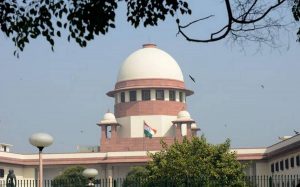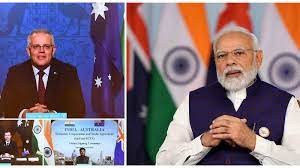Today Current Affairs: 5th April 2022 for UPSC IAS exams, State PSC exams, SSC CGL, State SSC, RRB, Railways, Banking Exam & IBPS, etc
Table of Contents
Indian Navy’s Second P-8I Squadron INAS 316 ‘Condors’:

Recently, the Indian Navy commissioned its second P-8I aircraft squadron – Indian Naval Air Squadron 316 –at INS Hansa, Goa.
- P-8I is a long-range, multi-mission maritime patrol aircraft.
- The P-8I aircraft is a variant of the P-8A Poseidon multi-mission maritime aircraft (MMA) operated by the US Navy.
- It was designed to protect the coastline and territorial waters of India.
- It can conduct anti-submarine warfare (ASW), anti-surface warfare (AsuW), intelligence, maritime patrol, and surveillance and reconnaissance missions.
- In January 2009, Boeing was selected by the Indian Government to supply eight P-8I maritime reconnaissance aircraft to the Indian Navy.
- The contract also included an option for four additional aircraft.
- The first P-8I was delivered to the Indian Navy in December 2012.
- The remaining aircraft were delivered between 2013 and 2015.
- In mid-2016, India’s Cabinet Committee on Security (CCS) approved the acquisition of the four additional P-8I aircraft from Boeing.
- Apart from India and the US, it has been chosen by six other militaries in the world.
- While the Indian Navy uses it for maritime operations, the aircraft was also used in eastern Ladakh in 2020 and 2021, when the standoff with China was at its peak, to keep an eye on Chinese troops and their manoeuvres.
- The Navy’s fleet has surpassed 29,000 flight-hours since their induction in 2013, and is responsible for coastal patrolling, search-and-rescue, anti-piracy, and supporting operations of other arms of the military.
- The first eight of these aircraft are stationed at INS Rajali in Arakkonam, Tamil Nadu, on the eastern coast.
- The batches of the additional four are part of another squadron at INS Hansa in Goa, named Indian Naval Air Squadron 316.
- Indian Naval Air Squadron 316 (INAS 316): A Squadron is an operational unit in an air force/army aviation/naval aviation consisting of two or more aircrafts and the personnel required to fly them.
- INAS 316 has been named ‘Condors’ after one of the largest flying land birds with a massive wingspan.
- Condors are known for excellent sensory capabilities, powerful and sharp talons and large massive wings symbolising the capabilities of the aircraft and envisaged roles of the squadron.
- This squadron has been specifically commissioned to be the home for the four new P-8I aircraft procured under the Option Clause contract and to ‘Deter, Detect and Destroy’ any threat in the IOR (Indian Ocean Region).
Khelo India University Games 2021:

2021 Khelo India University Games logo was unveiled recently. It will be held in Karnataka from 24th April 2022. At the Sree Kanteerava Stadium, Bengaluru the logo was unveiled.
- The Jain University, Bengaluru will be hosting this event from 24th April to 3rd May 2022.
- Anurag Thakur, Union Sports Minister, and Karnataka Governor TC Gehlot were present during the launch event.
- This event was postponed earlier due to the COVID-19 pandemic.
- This edition will be the second edition of the games.
- The first edition of the Khelo India University Games was held in Odisha in 2020.
- The official jersey for the games was also launched.
- The anthem for the 2021 Khelo India University Games has been sung by Nikhil Joshi and Chandan Shetty.
- Mallakhamb and Yogasana along with 18 other sports will be featured in the upcoming games.
- Nearly 4,500 athletes will be participating from across India.
- An app named Khelo India App was also launched by the state for providing live updates on the Games.
- Mascot: The official mascot of the Games is ‘Veera’, an elephant.
- Logo of the Games: The iconic Vidhana Soudha building which is the state of Karnataka’s Legislative House and is located in Bengaluru features in this year’s logo along with two elephants on either side.
Viktor Orban: Hungary’s New Prime Minister

Viktor Orban has again been elected as the Prime Minister of Hungary for the fourth time. He won the 4th term by a huge margin more than what was predicted in the pre-election polls.
- After the win, he addressed a jubilant crowd who were chanting his name.
- Many people in the gathering wore the orange party colour of Fidesz, the party of Viktor Orban.
- He is the longest-serving head of a government in the European Union.
- Six oppositions united to challenge him in this election and they were seeking to roll back the illiberal policies of Orban’s.
- The opposition claimed that the vote was unfair as they were all banished from the state media.
- Orban however said that the elections were conducted in a fair manner.
- Over 200 international observers monitored the Hungary elections along with thousands of volunteers from both electoral camps.
- 69 percent was the turnout for this year’s election.
Operation Upalabdh: RPF

Railway Protection Force (RPF) conducted a Pan India Drive against the alleged black marketeers under Operation Upalabdh.
- Earlier in February 2022, the RPF had launched a nationwide operation to curb human trafficking named Operation AAHT.
- The month-long drive under Operation Upalabdh has been able to curb the activities of touts substantially and make railway tickets available to the common man.
- The contingent of RPF is an Armed Force of the Union of India. It is a security force under the ownership of Indian Railways, Ministry of Railways.
- The history of the RPF dates back to 1882 when various railway companies appointed their own guards for protection of railway property.
- The force was declared as statutory force in the year 1957 by an enactment of Parliament subsequently declared as an Armed Force of the Union of India in the year 1985.
- The RPF Rules were enacted in 1959 and RPF Regulations published in 1966.
- In the same year, some limited powers to apprehend and prosecute offenders involved in railway property were conferred on the Force by enacting the Railway Property (Unlawful Possession) Act, 1966.
- Primarily RPF has been entrusted with responsibility of the safety of Railway property.
- But, while the provisions of RPF Act were soon found wanting for the maintenance of an effective and disciplined Force, the RPF Rules and Regulations too were found judicially unsound.
Human Genome:

Scientists had published the map of the human genome for the first time nearly two decades ago which was hailed as a breakthrough.
- In 2003, scientists got the breakthrough, but it was incomplete as about 8% of the human DNA was left unsequenced.
- Now for the first time, a large team has accounted for completing the 8% picture of the human genome.
- In 2020, the Ministry of Science and Technology had approved an ambitious gene-mapping project called the Genome India Project (GIP).
- A genome refers to all of the genetic material in an organism, and the human genome is mostly the same in all people, but a very small part of the DNA does vary between one individual and another.
- Every organism’s genetic code is contained in its Deoxyribose Nucleic Acid (DNA), the building blocks of life.
- The discovery that DNA is structured as a “double helix” by James Watson and Francis Crick in 1953, started the quest for understanding how genes dictate life, its traits, and what causes diseases.
- Each genome contains all of the information needed to build and maintain that organism.
- In humans, a copy of the entire genome contains more than 3 billion DNA base pairs.
10.5% Internal Reservation To Vanniyakula Kshatriya Community In Tamil Nadu:

The Supreme Court struck down the 10.5% internal reservation to Vanniyakula Kshatriya community in Tamil Nadu.
- The Supreme Court held that 10.5% internal reservation to Vanniyakula Kshatriya community violates the fundamental rights of equality, non-discrimination and equal opportunity of 115 other Most Backward Communities (MBCs) and De-Notified Communities (DNCs) in Tamil Nadu.
- The allotment of 10.5% reservation to a single community from within the total Most Backward Classes (MBC) quota of 20% in the State, leaving only 9.5% to 115 other communities in the MBC category, was without “substantial basis”.
- Further, the court said there was no assessment or analysis done prior to the 2021 Act to back the claim that the Vanniyakula Kshatriyas were relatively more backward than the other MBCs and DNCs.
- The court underscored that while caste can be the starting point for internal reservation, it is incumbent on the State government to justify the reasonableness of the decision.
- Though the court held the 2021 Act and its percentages of reservation unconstitutional, it upheld the legislative competence of the State to enact a law sub-classifying and apportioning percentages within identified backward classes.
Vanniyakula Kshatriya Reservation:
- Reservation in Tamil Nadu comprises 69% under a 1994 Act protected under the Ninth Schedule of the Constitution.
- Out off the 69%, backward classes, including Christians and Muslims, get 30%, MBCs get 20%, Scheduled Castes 18%, and Scheduled Tribes 1%
- The Vanniyakula Kshatriya reservation was provided under the State within the reservation for the Most Backward Classes and Denotified Communities Act, 2021.
- Vanniyakula Kshatriya (including Vanniar, Vanniya, Vannia Gounder, Gounder or Kander, Padayachi, Palli and Agnikula Kshatriya) community.
- The second Tamil Nadu Backward Commission in 1983, held that the population of Vanniyakula Kshatriyas was found to be 13.01% of the State’s total population.
- Therefore, provision of 10.5% reservation to a community with a population of 13.01% could not be called disproportionate.
Ind- Aus ECTA:

India signed a historic trade agreement with Australia, the India-Australia Economic Cooperation and Trade Agreement (Ind- Aus ECTA).
- In February 2022, India and Australia announced that they were going to sign such an agreement.
- The negotiations for India-Australia ECTA were formally re-launched in September 2021 and concluded on a fast-track basis by the end of March 2022.
- Economic Cooperation and Trade Agreement is the first Free Trade Agreement (FTA) that India has signed with a major developed country in over a decade.
- In February, India signed an FTA with the UAE and is currently working on FTAs with Israel, Canada, UK and the European Union.
- The Agreement encompasses cooperation across the entire gamut of bilateral economic and commercial relations between the two friendly countries, and covers areas like:
- Trade in Goods, Rules of Origin.
- Trade in Services.
- Technical Barriers to Trade (TBT).
- Sanitary and Phytosanitary (SPS) measures.
- Dispute Settlement, Movement of Natural Persons.
- Telecom, Customs Procedures.
- Pharmaceutical products, and Cooperation in other Areas.
- ECTA provides for an institutional mechanism to encourage and improve trade between the two countries.
- The ECTA between India and Australia covers almost all the tariff lines dealt in by India and Australia respectively.
- India will benefit from preferential market access provided by Australia on 100% of its tariff lines.
- This includes all the labour-intensive sectors of export interest to India such as Gems and Jewellery, Textiles, leather, footwear, furniture etc.
- On the other hand, India will be offering preferential access to Australia on over 70% of its tariff lines, including lines of export interest to Australia which are primarily raw materials and intermediaries such as coal, mineral ores and wines etc.
- Under the agreement, Indian graduates from STEM (Science, Technology, Engineering and Mathematics) will be granted extended post-study work visas.
- Australia will also set up a programme to grant visas to young Indians looking to pursue working holidays in Australia.




